Questions I ask myself when contemplating whether an excerpt from music literature is appropriate for illustrative purposes in class include: Which elements are typical? Which elements are atypical? Which elements generally considered to be typical do not appear in this excerpt? How typical are the typical elements? What is the distribution of typical elements, within an excerpt, a movement, or in different compositions? These questions often occur in relation to my counterpoint course regarding aspects of sixteenth-century style, and specifically concern the appearance of dissonance in the Palestrinian sacred repertoire. I decided, therefore, to make an enumeration of nine selected uses of dissonance in the Masses of Palestrina, and have found that such a study serves pedagogical purposes in at least five ways:
1. It provides sources in which there are several occurrences of any one specific device within a short span, useful as a resource for class illustration purposes.
2. It has provided the means to calculate a prototypical distribution of selected devices; that is, an average number of measures per movement and an average number of respective devices within the average number of measures. This has been used to select some movements approximating this prototypical distribution which can be employed for student analysis projects, in class, or on exams.
3. It provides a basis for judging the accuracy of generalizations regarding nonharmonic usage which are encountered in counterpoint texts and treatises.
4. It provides a basis for judging the "relative typicality" of the kind and amount of nonharmonic usage in selections included in anthologies.
5. Besides providing information regarding specific treatment of the various devices, it also provides sources to illustrate relatively uncommon occurrences.
The first step in the project was to complete a study of all the discrete three-voice sections in the Palestrina Masses, using the Fratelli Scalera complete edition as the source.1 (Since there are no three-voice Masses, selected were those sections of complete Mass movements that are separate and that are reduced to three-voice texture, such as the Crucifixus of the Credo, the Pleni sunt coeli of the Sanctus, and the Bendictus.) There are 73 such sections, having a total of 2,894 bars, occurring in 46 different Masses.
In the second part of the study, all the four-voice movements of the four-voice Masses were examined. There are 40 four-voice Masses, with 210 four-voice movements, having a total of 18,313 bars. All movements constituting the Ordinary of the Mass were included; only those sections having other than four-voice texture were not included.
I chose to enumerate those devices which, in my experience, seem to need highlighting for the sake of the student, at the juncture in the sixteenth-century counterpoint course where nonharmonic usage is being considered. The devices chosen include five suspensions (namely, the 9-8, the 7-6, the 4-3, the 2-3, and the 2-1), the accented passing tone (that is, the quarter-note value in 4/2 meter), the consonant fourth, the nota cambiata, and the 6/5 harmonic combination. Not included are unaccented passing tones, neighboring tones, portamentos, or pairs of eighth notes. Each occurrence of each device was tabulated and was further categorized according to the number of voices sounding at the point of the dissonance. Additional information regarding specific details pertinent to the use of the devices was recorded separately for each movement.
For the three-voice study, statistical results were arrived at manually. Some have also been done manually for the four-voice study, but in addition the data have been recorded on a computer using a system known as INTERACT which has great flexibility for editing and printout format, and is also subject to a packaged statistical analysis program for calculating desired information. For the four-voice Masses, therefore, there is a printout which lists all movements of all Masses (alphabetically by Mass title) and includes the number of each of the respective devices in each movement, and of those in two-, three-, and four-voice texture. The ratio of number of devices to number of measures appears below each entry of raw data. Totals for all Masses appear at the end of the listing. A second printout is arranged by movement rather than by Mass title. Thus all the Kyrie movements appear successively, followed by totals, then all the Gloria, Credo and similar movements. All the ratios were sorted and the 14 which indicate the greatest frequency of occurrence appear on a third printout, thus providing a list of the 14 movements having the relatively largest number of occurrences in the relatively fewest number of measures for each device in each of the possibilities (total, two-, three-, and four-voice texture). While it is not possible to list all statistical details here, illustrations of some of the information which has resulted from the study are included.
One of the first items of interest is the rank order and total number of occurrences of the selected nine devices. These appear in Table 1.
TABLE 1
TOTAL, RATIOS, AND PROTOTYPICAL DISTRIBUTION
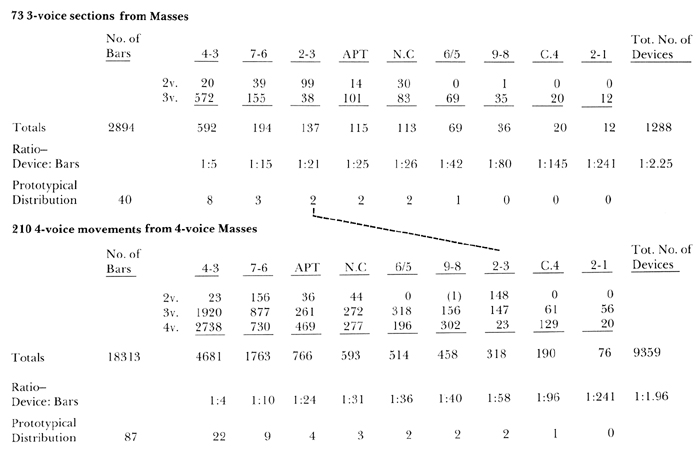
The devices are listed in rank order, descending, from left to right, first for the three-voice sections, and then for the four-voice movements. The number of occurrences of each device is given, including a breakdown showing two-voice and three-voice usage in the three-voice sections, and two-, three-, and four-voice usage for the four-voice movements. It is probably no surprise that the 4-3 suspension ranks first, or that the 2-1 suspension ranks last, but the list of the remaining devices should be of interest, both for the order and the amounts as well as for the fact that with only the exception of the 2-3 suspension, the order stays the same for the use of devices in the three-voice sections and the use in four-voice movements. (The dotted line in the middle of the table calls attention to the shift in order for the 2-3 suspension). Notice also that the breakdown into subgroups according to the number of voices sounding (at the point the device occurs) provides interesting information. Other than what is obvious for the harmonic 6/5, no occurrences were found of the consonant fourth or the 2-1 suspension in two voices, and only two 9-8 suspensions were found in two voices, one in the three-voice sections and one in the four-voice movements. (Since there was only the one in the four-voice movements, it is not included in the information available on the computer printout, and the entry appears in parentheses on the table.) While the 2-3 is third in rank order for the total number of occurrences in three-voice texture, it has the highest number of two-voice occurrences—far more than the 7-6, for instance. However, in the four-voice movements, the two-voice occurrences of the 7-6 outnumber those of the 2-3 by 156 to 148. In the four-voice movements there are more 7-6's, harmonic 6/5's, 2-3's, and 2-1's in three voices than in four.
Also included in Table 1 is the ratio of the number of occurrences of each device to the total number of bars, rounded to whole numbers. In the three-voice study, for instance, the 4-3 suspension occurs on an average of once every five bars, the 7-6 once every 15 bars, etc., while in the four-voice study, the 4-3 occurs once every four bars, the 7-6 once every ten bars, etc. These ratios serve as the basis for comparisons, and as the basis for arriving at the prototypical distribution which is also shown. In the three-voice sections, for example, for the average length of a section, which is 40 bars, the averaged or prototypical distribution is eight 4-3 suspensions, three 7-6 suspensions, two 2-3 suspensions, two accented passing tones, two nota cambiata figures, one harmonic 6/5, and no 9-8's, consonant fourths, or 2-1's. The information in the last column to the right shows the ratio of the total number of devices to the number of measures; in three-voice sections it is 1:2.25, in four-voice movements it is 1:1.96, indicating that the devices occur slightly more frequently in the four-voice movements than in the three-voice sections. Further discussion of the information on Table 1 will not be undertaken at this point, but the reader is encouraged to glean information from the Table as appropriate to meet needs and satisfy curiosity.
Examination of all the data recorded produced little information which could serve as the basis for suggesting tendencies or trends regarding the use of the nine devices. For instance, attention was given to changes that might occur, in some methodical pattern, throughout the compositional period. With one exception no such pattern emerged. The exception is that in the four-voice movements, 291 of the 593 nota cambiata figures occur in the first seven four-voice Masses (from volumes one and four of the Fratelli Scalera complete edition) and the remainder are distributed among the other 33 Masses, thus reflecting a marked decline in the employment of the cambiata. In the three-voice study, one tabulation grouped the entries according to the two most common voice combinations: cantus-altus-tenor and altus-tenor-bassus. The resulting ratios are quite similar to the ratios of the complete totals and there are only two instances of a change in rank order: in the cantus-altus-tenor arrangement, there are a few more nota cambiata figures than accented passing notes, and in the altus-tenor-bassus voicing there are two more 9-8 suspensions, than harmonic 6/5 combinations. Differentiation by text setting was also examined. In the three-voice study, separate totals were tabulated for the Crucifixus, the Pleni sunt coeli and the Benedictus settings. Again, with only a few instances of a slight shift in rank position, the resulting ratios are very similar to those for the totals. Totals for the four-voice study were computed by movement (all the Kyrie movements, all the Credo movements, etc.). These results appear in Table 2.
TABLE 2
COMPARISON OF TOTALS OF ALL MOVEMENTS TO TOTALS BY TYPE OF MOVEMENT
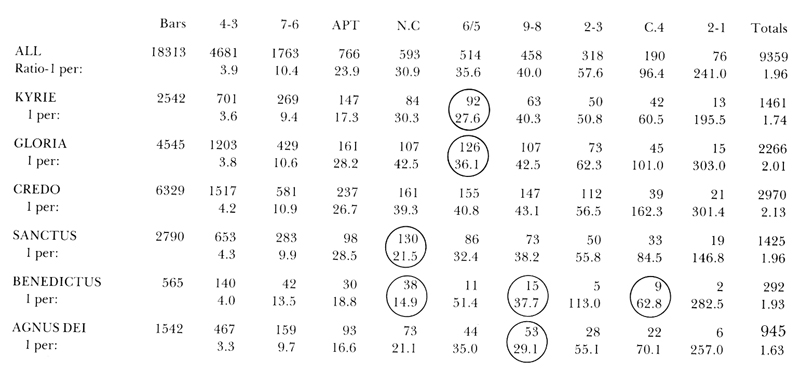
Most ratios for the movements are quite similar to those for the total of all movements. The rank order changes are indicated by the encircling of an entry whose raw score is higher than that of the entry to its left. On the basis of the ratios appearing in the right hand "Totals" column, the generality can be made that there is a slightly greater frequency of the devices in the shorter movements (Kyrie, Benedictus, Agnus Dei) than there is in the longer movements (Gloria and Credo), but the differences do not seem terribly significant.
Besides the numbers of occurrences of the devices, special conditions sometimes attendant to each respective device were recorded. Included in the four-voice study for example are instances such as 104 suspensions in which the resolution note is already present in an accompanying voice, 851 4-3 suspensions accompanied by the melodic 6-5, 26 9-8 suspensions in which the ninth is a minor ninth and not a major ninth, various harmonic combinations with the 2-3 suspension, 63 accented passing tones approached by parallel dissonance or by leap to a dissonance, aspects of the preparation and resolution of the 6/5 harmonic combination, and 36 consonant fourths preceded by the harmonic 6/5.
Also listed were instances of the use of double nonharmonic devices. In the basic tally, each part of a double nonharmonic device was counted individually (for instance, a 9-8/4-3 double suspension was tallied as one 9-8 and one 4-3); therefore it was necessary to keep separate information regarding all such occurrences. Results of this tabulation appear on Table 3.
TABLE 3
DOUBLE NON-HARMONIC DEVICES
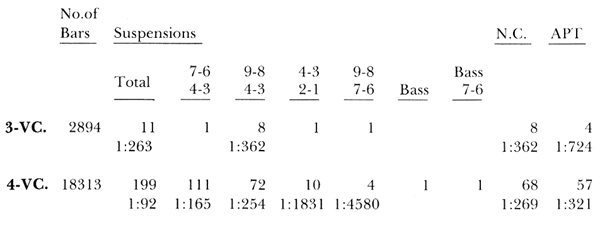
Notice that the double suspensions are subdivided into specific combinations, that there are more double suspensions than double nota cambiata figures or double accented passing tones, and that there are many more double suspensions in four-voice movements than in three, with a correspondingly greater frequency of occurrence. Obviously it is necessary to subtract the number of suspensions involved in combinations from the totals which appear in Table 2 to get the number of single suspensions. For example, there are 193 4-3 suspensions in a double-suspension combination; therefore, of the total 4,681 4-3 suspensions, 4,488 are single suspensions.
Another item of interest is the number of different devices in any one movement. Table 4 shows graphically the percentage of the number of movements with the respective number of different devices.
TABLE 4
PERCENTAGE OF NUMBER OF MOVEMENTS WITH
RESPECTIVE NUMBER OF DIFFERENT DEVICES
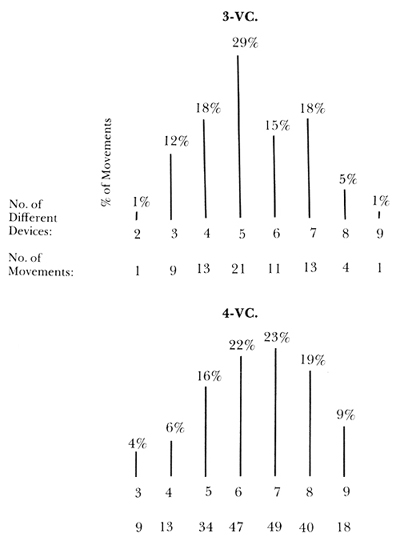
For instance, the three-voice sections, only one, or one percent, has just two different devices; nine sections, or twelve percent have three different devices; thirteen, or eighteen percent have four different devices, etc. The largest percentage (i.e., 29 percent) of the three-voice sections contains just five different devices, and only one has all nine devices. (Frankly, for pedagogical purposes, I was hoping to find a few more with all nine.) In the four-voice movements, graphed at the bottom of Table 4, notice that the distribution among movements with five, six, seven, and eight different devices is quite evenly balanced, and that there are eighteen movements, or nine percent of the total, that have all nine devices.
Of the previously-mentioned five purposes which the results of the study could serve, the first is to provide sources with many occurrences of each respective device. Specific references from the three-voice sections are in Table 5, and references from the four-voice movements are in Table 6.
TABLE 5
LARGE NUMBER OF OCCURRENCES OF
EACH RESPECTIVE DEVICE
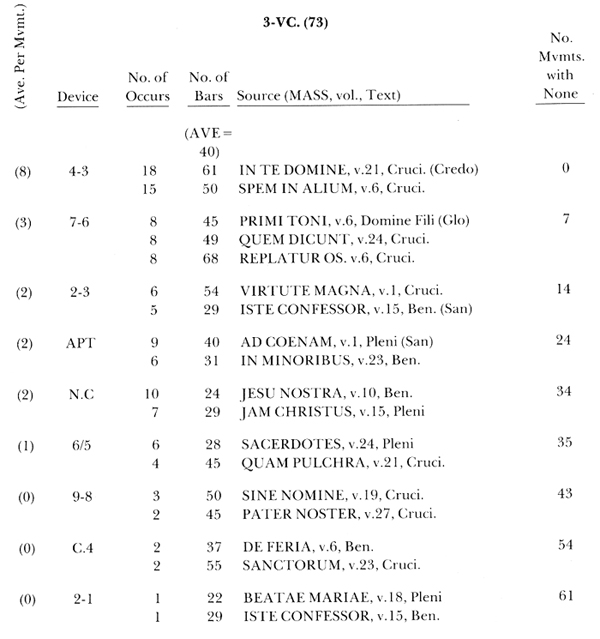
TABLE 6
LARGE NUMBER OF OCCURRENCES OF
EACH RESPECTIVE DEVICE
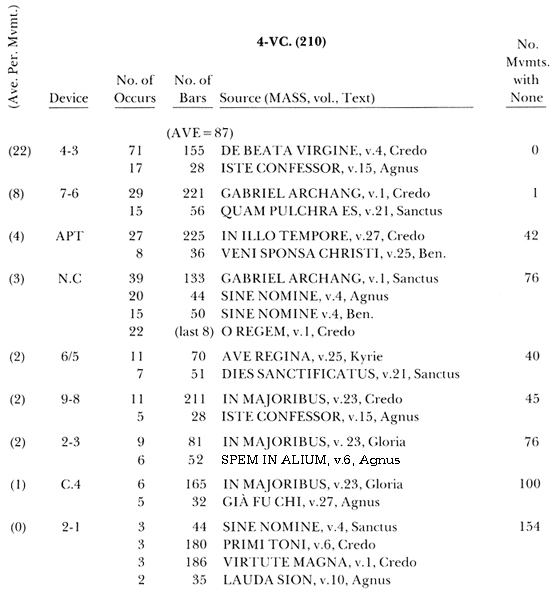
The left column of each Table gives the average number of occurrences per movement of each device so that this may be compared to the number in these selected movements. Then for each device the movement with the largest number of that device is given, followed by one or two more examples that have, for that device, a frequency ratio of number of occurrences to number of bars which reflects a relatively large number of occurrences in a relatively few number of measures. The right hand column of each table contains the number of movements in which there are none of each of the respective devices. These tables should provide valuable resource information for those who may be teaching sixteenth-century counterpoint and are searching for illustrations of specific individual devices from the Palestrinian literature.
The second purpose of the study is the selection of some movements which approximate the prototypical distribution of the devices. Table 7 has selections from the three-voice sections.
TABLE 7
EXAMPLES WHICH APPROXIMATE THE PROTOTYPICAL DISTRIBUTION3-VC
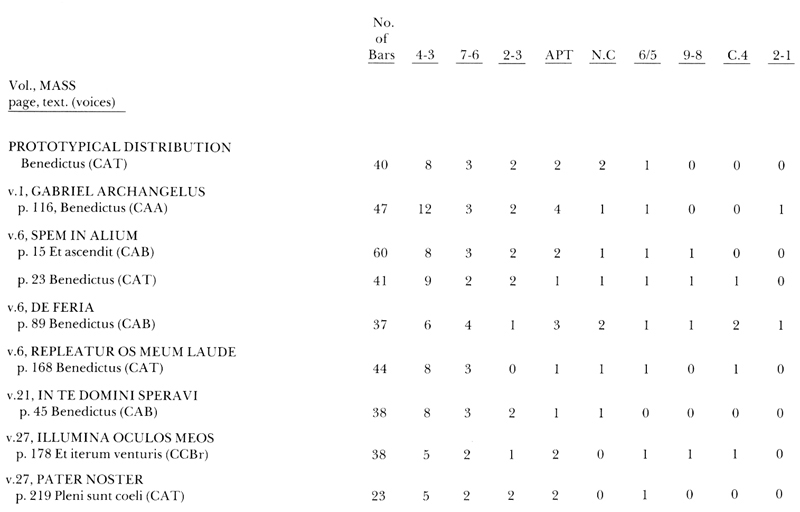
The prototypical distribution appears first, again to assist in making comparisons. Included within the three-voice selections is the Benedictus from the Mass De feria, from volume six of the complete edition, which is the only one of the 73 three-voice sections that contains at least one occurrence of all nine devices. Information for the four-voice movements is in Table 8.
TABLE 8
EXAMPLES WHICH APPROXIMATE THE PROTOTYPICAL DISTRIBUTION4-VC
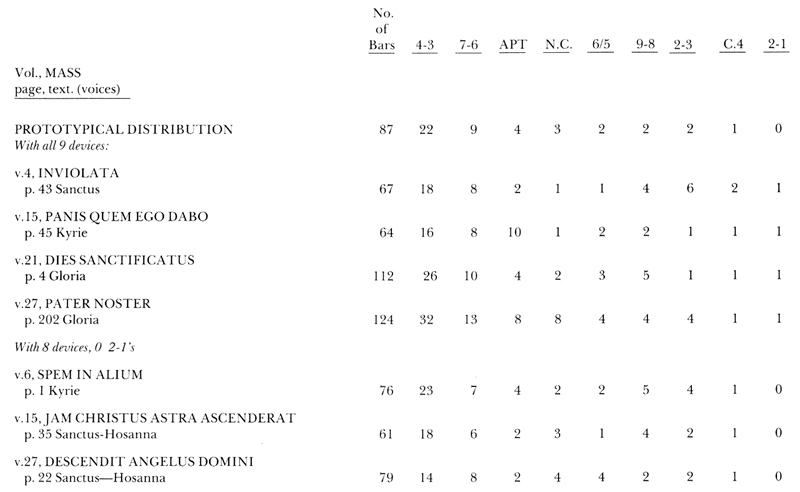
The first four examples all contain one of each of the nine devices. The last three are selected from those movements that lack only the 2-1 suspension, since this reflects the arrangement in the prototypical distribution.
The third purpose is to use the information to evaluate generalizations found in counterpoint books. Statements that have to do with some aspect of the amount or relative degree of use of some of these devices may be found in books by authors such as Kitson, Merritt, Jeppesen, Soderlund, N.K. Andrews, Bassett, and Benjamin. For the most part the statistics do support the statements that one encounters, but sometimes the information is incomplete, misleading, or incorrect. A few selected examples must suffice to illustrate the possibilities of statement evaluation. H.K. Andrews writes, "the most commonly found suspended dissonances above the bass . . . (are the) 7-6 and 4-3."2
The information on Table 1 does not support this, but in this case as well as in several others the statistics lend further insight, because it would be appropriate to point out that many more examples of 4-3 than 7-6 occur, and that there is a difference depending on whether two-voice texture or texture with three or more voices is being considered.
Concerning double suspensions Bassett writes, "Of all the possible double suspensions, only two are easily found: the 7-6/4-3 and the 9-8/4-3."3 These two double suspensions are indeed those which occur most frequently in the four-voice Masses, which can be verified by referring to Table 3. However, it does seem that authors are more likely to point out those items that occur seldom or never. For instance, immediately following the previously quoted statement in the Bassett manual concerning the 7-6/4-3 and 9-8/4-3 double suspensions, he says, "The 9-8/7-6 double suspension, while theoretically quite acceptable, was for some reason not used by Palestrina."4 This unfortunately, is not a true statement, since as can be seen from Table 3, one example was found in the three-voice study and four examples were found in the four-voice study. The last example of a generality from a text is on the same subject of double suspensions. Benjamin says that the 4-3/2-1 is among the typical double suspensions, but that the 7-6/4-3 is rare (because "it produces ineffective parallel fourths").5 This gives an impression which is just the opposite of what actually occurs, since in the four-voice Masses, there are 111 7-6/4-3 double suspensions and only 10 which are the 4-3/2-1 combination. While the process of statement evaluation may have to take into account factors beyond total of occurrences (as was done during the course of this study), it is possible that in many instances information contained in the tables accompanying this article will be applicable.
The fourth of the five purposes is to provide a basis for comparison to selections in anthologies or texts, assuming that among other things the occurrence and distribution of dissonance is a consideration in making a choice of a composition to use. The prototypical distribution (see Table 1) provides a standard against which to compare the number of measures and number of nonharmonic devices found in such sources. As part of this study, 19 examples of sixteenth-century sacred polyphony in three voices from nine different anthologies or texts were examined. The distribution of dissonance within most of the 19 examples does not come very close to the prototypical distribution, but of the 19 examples, 9 are three-voice sections from the Palestrinian Masses, and two of these are included on Table 7 as examples which approximate the prototypical distributions. One is the Benedictus from the Mass Gabriel archangelus and it is found in two books, in the collection of Soderlund6 and in the text by Benjamin.7 The other selection is the Benedictus from the Mass Repleatur os meum laude. This is also found in the Soderlund collection,8 and is included as well in the AtKisson text.9 The intent regarding this fourth purpose is not to suggest that selections in texts and anthologies are, are not, or should be based on the distribution of dissonance, but rather it is to suggest that it may often be in order for a teacher to call to the attention of students that certain aspects of a composition may contain some elements (or have omissions) which are not necessarily representative of a larger corpus of works, and in the case of Palestrina Mass movements, the information gathered enables one to be more specific concerning the kinds and amounts of nonharmonic devices which are encountered.
The fifth and last purpose is to accumulate a list of sources that illustrate devices used so seldom that they are considered rare or exceptional. While it is not the purpose of this report to give detailed information regarding these cases, the types of items include 4-5 or 7-8 lower-voice suspensions, the suspended diminished fifth, augmented triads in 6/3 position, diminished triads in 5/3 position (which are on a weak beat, and do not follow a 6/5), four eighth notes in a row, quarter note tones, high-note law exceptions, use of the Landini sixth melodic pattern, leaps to and/or from a dissonance, an upper neighbor tone in a half-note value, and syllable change with quarter notes.
A brief idea of the analytical study undertaken has been presented, along with some examples of specific resource information. Admittedly, further work is possible, including the enumeration of devices in five-voice (and more) Masses, in works other than Masses, and in works of other composers of the period, in both sacred and secular categories. But what has been done should help to substantiate the premise that the process of enumeration can play an important role in the ultimate product of illumination.
1Giovanni Pierluigi da Palestrina, Le opere complete (Rome: Fratelli Scalera, 1939- ).
2Herbert Kennedy Andrews, An Introduction to the Technique of Palestrina (London: Novello and Company, 1958), p. 117.
3Leslie Bassett, Manual of Sixteenth-Century Counterpoint (New York: Appleton-Century-Crofts, 1967), p. 40.
4Ibid.
5Thomas Benjamin, The Craft of Modal Counterpoint (New York: Schirmer-Macmillan, 1979), p. 100.
6Gustave Soderlund, Examples of Gregorian Chant and Works by Orlandus Lassus, Giovanni Pierluigi Palestrina and Marc Antonio Ingegneri, 3rd ed. (New York: Appleton-Century-Crofts, 1946), p. 166.
7Benjamin, op. cit., p. 86.
8Soderlund, op. cit., p. 70.
9H. AtKisson, Basic Counterpoint (New York: McGraw-Hill, 1956), pp. 142-44.


